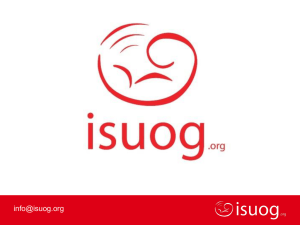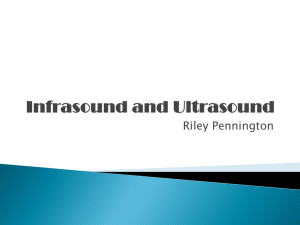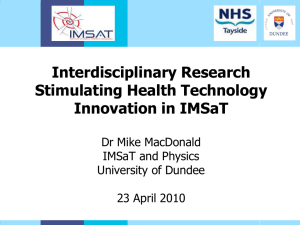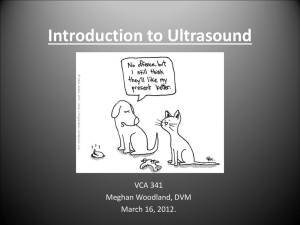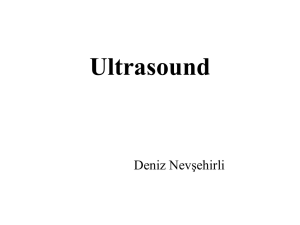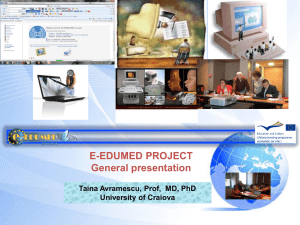Safety - European Federation of Societies for Ultrasound in Medicine
advertisement
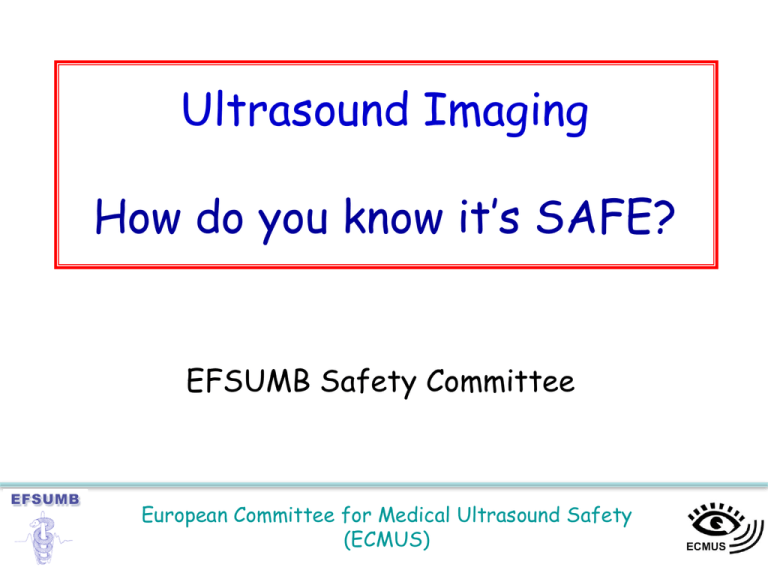
Ultrasound Imaging How do you know it’s SAFE? EFSUMB Safety Committee European Committee for Medical Ultrasound Safety (ECMUS) Why are we concerned about safety? • The range of clinical applications is becoming wider • The number of patients undergoing ultrasound examinations is increasing • New techniques with higher acoustic output levels are being introduced. European Committee for Medical Ultrasound Safety (ECMUS) What are bio-effects? The result of ultrasound interacting with biological molecules as it passes through tissue European Committee for Medical Ultrasound Safety (ECMUS) Safety Is a bioeffect likely to cause a problematic change (e.g. cell, gene or DNA damage) ? European Committee for Medical Ultrasound Safety (ECMUS) Mechanisms of Action Heat (Ispta) Cavitation (P-) European Committee for Medical Ultrasound Safety (ECMUS) INCIDENT BEAM Attenuation = Absorption + Scatter IMAGE Absorption 60-80% HEAT European Committee for Medical Ultrasound Safety (ECMUS) HEATING (Absorption) Increases with: frequency, exposure duration, pulse repetition frequency European Committee for Medical Ultrasound Safety (ECMUS) Pulsed Doppler Colour Doppler Harmonic imaging B-mode 2D,3D M-mode 2 European Committee for Medical Ultrasound Safety (ECMUS) Transducer Self Heating : Temperature distribution due to probe self-heating for diagnostic devices (maximum) : B-Mode Ispta = 11 mW cm2, MI = 0,5 Pulsed Doppler Ispta = 533 mW cm2, MI = 0,9 Colour Doppler Ispta = 606 mW cm2, MI = 0,3 ATL UM 9 International limits for probe surface temperature due to self-heating : (Linear-Array L 10-5) T < 41 °C (in a water bath 2 l / 10 min) IEC 601-2-5 T < 43 °C (coupled to skin) T < 50 °C (emitting into air) IEC 60601-2-37 European Committee for Medical Ultrasound Safety © CKollmann, Euroson 2010 (ECMUS) Thermal Effects Biological consequences of heat depend on temperature rise and duration. European Committee for Medical Ultrasound Safety (ECMUS) Thermal Effects Tissues containing a large component of actively dividing cells are most sensitive to the effects of heat. European Committee for Medical Ultrasound Safety (ECMUS) ACOUSTIC CAVITATION European Committee for Medical Ultrasound Safety (ECMUS) Cavitation European Committee for Medical Ultrasound Safety (ECMUS) Acoustic Cavitation • Formation/activity of gas filled bubbles in an ultrasound exposed medium • At MHz frequencies bubble radius ~1 µm • Stable cavitation – bubbles oscillate • Inertial cavitation – bubbles expand too far then collapse very rapidly, releasing enough energy to damage tissue European Committee for Medical Ultrasound Safety (ECMUS) Inertial Cavitation European Committee for Medical Ultrasound Safety (ECMUS) How does the risk of heating & cavitation change with imaging conditions? European Committee for Medical Ultrasound Safety (ECMUS) Cavitation Heating Output Power Cavitation Heating Contact time 2 2 Decreasing importance Heating Frequency Increasing importance European Committee for Medical Ultrasound Safety All modes (ECMUS) Cavitation Increase Heating Deeper/more focal zones 2 Heating Narrow Sector format 2 European Committee for Medical Ultrasound Safety Imaging & M-mode (ECMUS) 2 Heating Sector format Cavitation Heating M-mode Other Factors which may influence Heating and cavitation Range Gate Width (pulse length may vary with gate width) Range Gate Depth (power may increase with depth) Doppler Velocity Range 2 (pulse repetition frequency may increase) European Committee for Medical Ultrasound Safety Pulsed Doppler (ECMUS) Receiver Gain has NO effect on heating or cavitation So ….. Maximise it! 2 European Committee for Medical Ultrasound Safety (ECMUS) Thermal Effects A diagnostic exposure that produces a maximum in situ temperature rise of no more than 1.5C above physiological levels (37C) may be used clinically without reservation on thermal grounds WFUMB 1992 European Committee for Medical Ultrasound Safety (ECMUS) WFUMB’98 - 01 Thermal Effects A diagnostic exposure that elevates embryonic and fetal in situ temperature above 41oC (by 4oC) for 5 min should be considered to be potentially hazardous. WFUMB 1992 European Committee for Medical Ultrasound Safety (ECMUS) “On Screen” Labelling Designed to provide safety related information AIUM/NEMA Output Display Standard European Committee for Medical Ultrasound Safety (ECMUS) THERMAL INDEX (TI) The Thermal index (TI) is an on-screen guide to the user of the potential for tissue heating. Estimate of the tissue temperature rise in ºC which might be possible under "reasonable worst-case conditions” European Committee for Medical Ultrasound Safety (ECMUS) THERMAL INDEX TI = Acoustic Power Output (Acoustic Power to produce a 1oC rise) European Committee for Medical Ultrasound Safety (ECMUS) THERMAL INDEX Soft tissue index TIS Bone TIB TIC – bone near transducer European Committee for Medical Ultrasound Safety (ECMUS) MECHANICAL INDEX The Mechanical index (MI) is an on-screen guide of the likelihood and magnitude of nonthermal effects. European Committee for Medical Ultrasound Safety (ECMUS) MECHANICAL INDEX (MI) MI = p/f P: in situ pressure f: frequency European Committee for Medical Ultrasound Safety (ECMUS) Power setting High power low gain Lower power high gain European Committee for Medical Ultrasound Safety (ECMUS) Power setting High power low gain Lower power high gain European Committee for Medical Ultrasound Safety (ECMUS) From scientific evidence of ultrasoundinduced biological effects to date, there is NO REASON to withhold diagnostic scanning during pregnancy, provided it is 1. medically indicated 2. is used prudently by fully trained operators. European Committee for Medical Ultrasound Safety (ECMUS) Ultrasound exposure during pregnancy With increasing mineralisation of fetal bones, the possibility of heating sensitive tissues such as brain and spinal cord increases. So …. extra vigilance is advised European Committee for Medical Ultrasound Safety (ECMUS) 3D imaging No additional safety considerations (particularly if there are significant pauses during scanning to study or manipulate the reconstructed images) European Committee for Medical Ultrasound Safety (ECMUS) 4D imaging (real-time 3D) Involves continuous exposure Guard against prolonging examination times unduly to improve the recorded image sequence beyond that necessary for diagnostic purposes. European Committee for Medical Ultrasound Safety (ECMUS) Ultrasound Contrast Agents (UCAs) • UCAs are not licensed for pregnancy • Caution should be exercised when using in tissues for which damage to microvasculature may be important (eg. eye, brain, neonate) •Exercise caution when using UCAs in patients with severe coronary artery disease and pulmonary hypertension. Keep MI low, and avoid long exposure times Refer to EFSUMB CEUS guidelines (2011) European Committee for Medical Ultrasound Safety (ECMUS) OBSTETRIC SCANNING THERMAL INDEX 0.5 0 1.0 1.5 2.5 2.0 3.0 0.7 RECOMMENDED RANGE PROVIDED ADEQUATE IMAGES CAN BE OBTAINED < 60 mins < 30 mins < 15 mins <4 mins <1 min NOT RECOMMENDED for OB scanning (especially in 1st trimester) Unlimited time Observe ALARA Recommended scanning time limits for these TIs (observe ALARA) Monitor TIS up to 10 weeks post-LMP, TIB thereafter. http://www.bmus.org/policies-guides European Committee for Medical Ultrasound Safety (ECMUS) Epidemiological safety studies Recent systematic reviews: • Torloni MR. WHO systematic review of the literature and meta-analysis. UOG 2009;33:599-608 • Whitworth M. Ultrasound for fetal assessment in early pregnancy. Cochrane Database Syst Rev 2010 • Salvesen KÅ. Ultrasound in pregnancy and non-right handedness: meta-analysis of randomized trials. UOG 2011;38:267-71 European Committee for Medical Ultrasound Safety (ECMUS) Only one controversial issue Prenatal ultrasound is associated with left-handedness Published studies Year Journal 1. author Type of study 1993 1998 2001 2002 2011 2011 Salvesen Kieler Kieler Kieler Heikkilä Salvesen RCT RCT Cohort Cohort RCT Meta-analysis BMJ Early Hum Dev Epidemiology Epidemiology Ultrasound Obstet Gynecol Ultrasound Obstet Gynecol European Committee for Medical Ultrasound Safety (ECMUS) Meta-analysis Forrest plot from Salvesen UOG 2011;38:267-71 European Committee for Medical Ultrasound Safety (ECMUS) We should worry – why? • 5 epidemiological studies demonstrate an increased risk of left-handedness of 15-30% • No other epidemiological study on ultrasound and handedness has been published • Experimental studies indicate effects on the brain in some animal models • Modern scanners produce higher outputs European Committee for Medical Ultrasound Safety (ECMUS) We should not worry – why? •Being left-handed is normal (10-15% of population) •A statistical association does not imply a causal relationship •The biological plausibility of this association is questionable European Committee for Medical Ultrasound Safety (ECMUS) Safety Statements European Committee for Medical Ultrasound Safety www.efsumb.org/ecmus British Medical Ultrasound Society www.bmus.org World Federation for Ultrasound in Medicine & Biology www.wfumb.org European Committee for Medical Ultrasound Safety (ECMUS)
![Jiye Jin-2014[1].3.17](http://s2.studylib.net/store/data/005485437_1-38483f116d2f44a767f9ba4fa894c894-300x300.png)

